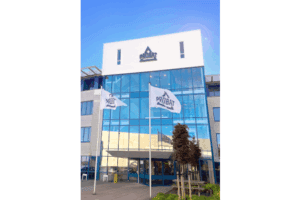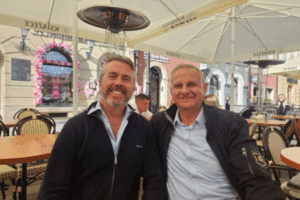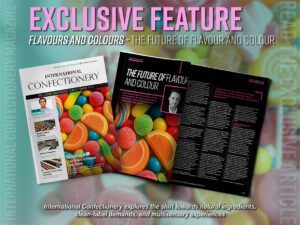International Confectionery’s Technical Editor, Clay Gordon, looks at the development of 3D printing for chocolate and the different techniques required for a perfect finish.
As with many modern technologies, the general idea of 3D printing was first foreshadowed by a science fiction writer – Murray Leinster – in a 1945 short story, Things Pass By. It took more than 40 years for the most generic form of 3D printing in use today: fused filament deposition (aka FFD), to be developed. In the late 1980s and early 1990s these machines cost several hundreds of thousands of dollars, but when the patents on FFD expired in 2009, prices for these additive manufacturing machines plunged to as low as under $1000, sparking much wider interest in the technology among an emerging maker community who were looking for alternatives to techniques such as CNC (computer numerical control) milling. 3D printing machines, in addition to becoming inexpensive and widely available over the past two decades made it possible to manufacture objects that were previously impossible to create using other techniques.
“it is not uncommon for a print to stall in the middle of a print, akin to a paper jam in a laser or inkjet printer”
FFD printing is referred to as ‘additive manufacturing’ because 3D printed models are built up one layer at a time. Because each new layer is built on top of the previous layer and must support the one above it, 3D models must first be ‘sliced’. It is these slices that are sent to the 3D printer, serially. Because of this process, it is possible to conceive of 3D geometries that cannot be printed, making designing for 3D printing a blend of art and mechanical engineering.
Can we print chocolate?
As a printing material, chocolate Is unique. Unlike a plastic filament, which is melted at the point it is applied, printing with chocolate, as opposed to compound, requires that the chocolate be kept in temper until it is deposited. Furthermore, chocolate can slump as it is being deposited and contract as it cools, a function of the fluidity of the chocolate. Fineness of surface detail is determined by the diameter of the opening of the nozzle in the print head as well as the smallest distance the print head can move consistently.
While 3D printing machines themselves may have become increasingly less expensive, printing chocolate has never been extremely fast when compared with widely used surface decoration techniques such as transfer sheets and airbrushed coloured cocoa butter. The fit and finish of 3D printed chocolate pieces left – and still leave – many people wondering what all the fuss was about.
Today there are several hobbyist-level 3D printers available. These tend to be built on top of popular FFD machines or food printers that have been adapted with heated reservoirs to hold the molten tempered chocolate. In some platforms, print cartridges holding measured amounts of specific chocolates are used. Manufacturers can design these cartridges specifically to keep the chocolate at specific temperatures, which will differ for dark, milk, and white chocolate recipes. Other modifications include temperature-controlled cabinets that keep the working space (called the build volume) at a constant temperature so that changes in ambient room temperature do not affect the print while it is progressing. One drawback that all the current 3D chocolate printing machines share is that they are slow. Small pieces can take many minutes and large pieces can take hours. Furthermore, it is not uncommon for a print to stall in the middle of a print, akin to a paper jam in a laser or inkjet printer. The longer the print time the greater the likelihood of a stall.
This does not mean that printing chocolate with inexpensive 3D printers is a non-starter, just that it is important to acknowledge what the characteristics of the medium are and to seek applications where those characteristics can be used to advantage, not seen as insurmountable hurdles. Several printing techniques, in addition to additive 3D, are available to people looking for customised and personalised decoration options from one-offs to hundreds with short lead times and low to no setup costs.
Adapting methods for individual needs
As with most technologies, the challenges of 3D printing chocolate can be met if sufficient resources are applied, and the universe of problems is approached from a whole-systems design perspective. The is the route the Mona Lisa division of Barry Callebaut took in developing its 3D Studio.
“3D printing machines made it possible to manufacture objects that were previously impossible to create using other techniques”
The surface resolution and finish can be addressed, in part, by gaining a deeper understanding of the fluid dynamics of chocolate. This understanding will guide the development of nozzles and pumps which can deliver the chocolate precisely, knowing how it will flow once it leaves the nozzle. The requirement to print hundreds of pieces – or even thousands – can be solved by building a suite of printers connected by sophisticated materials handling mechanisms that resemble robotic assembly lines, reducing human intervention and handling. Specialised software controls the manufacturing process itself, built on top of sophisticated design software that ‘understands’ the unique flow characteristics of chocolate as a printing medium.
When asked, Andrew Buffton, a member of the Barry Callebaut team who helped guide the build-out of the 3D Studio, says: “Surprisingly, printing dark chocolate is harder than printing either milk or white chocolate.”
The Studio model is a service business. Clients approach Mona Lisa with a design in mind and the trained design staff work with the client to ensure the design can be printed. Part of the iterative process is to educate the client about the applications for 3D printing – what the technology is good at doing. For now, the only studio is in Europe, but if the market acceptance for the service is high enough, the company plans to open manufacturing operations in other parts of the world, keeping the design service centralised. By moving manufacturing closer to where the finished product will be used, the cost and carbon footprint associated with long-distance shipping is reduced, as is the possibility of breaking what are often quite delicate pieces.
Modified inkjet printers have been available for some time that can be used to print on acetate transfer sheets using edible inks. This is an attractive option in cases where the number of sheets that need to be printed is below the MOQ for a custom print run and when the turnaround time makes sending a design out impractical.
Boutique Chocolat in Ireland has taken another approach to inkjet printing, choosing to print directly on plaques of chocolate using heavily modified inkjet printers and customised print driver software. While printing can only be done on white chocolate (which does influence the vibrancy of colours and on the contrast of the printed image as the inks are translucent), speed and flexibility, coupled with the ability to print continuous tone images not just line art are hallmarks of Boutique Chocolat’s technology. They are producing and offering lines of chocolate gifting cards for retail sale and offer custom printing services in runs short and long. If the artwork can be printed on a conventional inkjet or laser printer on paper it can be printed on white chocolate.
Noteworthy Chocolates in the US opted to explore surface engraving chocolate using lasers, which presented unique challenges. The first of these is making the engraving visible and legible at any viewing angle. At the same time, it is necessary to control the power of the laser to ensure the chocolate is not scorched, rendering the printed chocolate piece inedible. As with inkjet printing, laser engraving can be quite fast making it cost-effective to print hundreds of pieces, but unlike inkjet printing it is possible to engrave on dark and milk chocolate, not just white chocolate. One hallmark of laser engraving is the ability to achieve fine detail, although it is not possible to print continuous tone images, just line art. Most of Noteworthy’s business is personalising existing designs with text provided by the customer during the online ordering process. Custom designs are possible, but because of technical aspects of the laser engraving process, artwork must first be assessed by a member Noteworthy’s design team.
3D printing and high-speed surface decoration technologies are ushering in a new era of personalisation, customisation, and shape options not available even five years ago. Great strides have been made to date in reducing the cost and improving the quality of the finished goods. With some technologies the ability to manufacture unique pieces economically in runs as small as one piece or as large as thousands is within reach. As with many technologies, once there is market acceptance, increased levels of innovation in hardware and software deliver new creative and production capabilities that drive economies of scale, also enabling the merging of techniques in a single line. Today, there are decorating robots for enrobing lines that use machine vision to identify pieces on a moving belt, locate them in 3D space, and apply a surface decoration technique. Could such a robot be integrated into a 3D printing production line? Only time will tell.
Andrew Bufton, Global R&D Process Technology Manager, Barry Callebaut says:

“Chocolate is a unique material to print with, one that comes with specific expectations on the part of customers when it comes to surface finish – fine details and the sheen of well-tempered chocolate. Mona Lisa is not the first company to attempt 3D printing in chocolate, there are many machines in the market that can print 3D geometries in chocolate, but none (in our opinion) have successfully met the market demands for the level of surface resolution and finish quality, coupled with the ability to print at scale, that make 3D printing chocolate commercially viable.
It was not just enough to work on the printing technology itself, which we had to do, we also needed to understand chocolate as a structural material which is quite different from understanding its fluidity, which is also critically important, as is how the chocolate behaves as it cools down from its printing temperature. We need to know if an element of a design will hold up under its own weight, or if the angle of a joint will make a piece too delicate and break easily – and that’s going to be different for each chocolate; dark chocolates are very different from milk chocolate in terms of their structural characteristics and not all dark chocolates print the same. The information about the chocolates is built into the design tools so it can be considered when the files that end up being printed are generated.
We also discovered that not every chef knows how to construct 3D models that can be printed, and that’s why we ended up with the design studio concept. We work closely with our customers to take their ideas and make sure they understand what the technology is capable of, what good and bad applications of the technology are, and to ensure their designs can be printed.
It usually takes 60-90 days from when a final design is approval to when it arrives at a customer’s door. One challenge we face on top of manufacturing pieces that may not be obvious at first is figuring out how to package finished pieces, so they survive shipping – our work does not end with the printed piece itself.”
Danny Cohen, Founder, Boutique Chocolat says:

“It didn’t take me too long to learn that the available 3D printing technology for chocolate could not deliver the quality I was looking for and even if it could, it was too expensive because it was very slow. And not all 3D models can even be printed, so I started looking for other technologies.
I began to experiment with ways to print directly on white chocolate instead of printing onto acetate transfer sheets. This required working with an engineering company to develop custom transport mechanisms and adapting ink-jet printers to enable us to move polycarbonate moulds with tempered chocolate in them under the printhead like paper – with the same precision and resolution. Not only that, but if you can print it on paper, it can be printed on chocolate. No exceptional design skills required.
Printing directly onto chocolate with food-safe inks turns out to be faster and a lot more flexible than printing acetate transfers and there are no problems associated with very precise registration.
Our software enables us to not only print a unique design on each piece if we want to, but we can also take the same basic design and personalise it by, for example, changing a name from one piece to the next.
We can easily and inexpensively print several hundred pieces per day on a single printer. It is also easy to pack up a printer and take it on road trips, adding a specialised heater to the transport so we don’t have to bring a tempering machine as well. This means we can produce personalised chocolate pieces in very nearly real-time at trade shows, festivals, and at in-store demos.”
Jennifer Sauvageau, CEO, Noteworthy Chocolates says:

“Figuring out how to engrave chocolate using a laser was just the first technical hurdle we had to overcome. It is the work we have done automating our production processes – both custom software and custom hardware – that has made scaling the business possible.
While in one respect we do engrave each and every piece individually, one at a time, we have had to develop ways to gang multiple pieces into the engraver at once so we can produce more than one piece in a print run. Our custom software enables us to print a different base image on consecutive pieces or we can run the same base image and customise it with a different message on any number of consecutive pieces. The largest size we currently engrave is 6×8 inches (~150x200mm) and it takes a maximum of three to four minutes to fully engrave that size. One characteristic of lasers is their ability to etch very fine lines, which turns out to be both an advantage and a disadvantage. We can engrave very intricate designs but engraving large solid areas does take time.
Most of our customers use designs and fonts from our library, making it easy for most orders to be taken on our website without having to manually review them. We do produce pieces with customer–supplied artwork, but our in-house design team reviews the artwork and makes modifications, if necessary, before sending the file to the engraver. While getting a custom design like a logo ready to engrave takes from a few minutes to up to a week depending on the complexity of the image, testing to avoid burning and blooming, and the time it takes to communicate with the customer, once the design is approved each piece only takes a few minutes to produce.”
Image credit: Chef Davide Comaschi – MONA LISA 3D STUDIO
To stay up to date on the latest, trends, innovations, people news and company updates within the global confectionery market please register to receive our newsletter here
Media contact
Kiran Grewal
Editor, International Confectionery
Tel: +44 (0) 1622 823 922
Email: [email protected]








